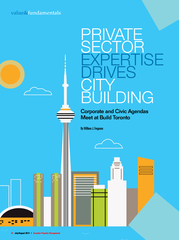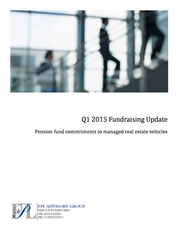Description
value&fundamentals
“The city receives monetary benefits
in so many other forms – fees, dues,
levies, construction jobs, the ongoing
impact on the valuation of surrounding
assets and ongoing taxation dollars,"
Hutcheson adds. "So there is a
commercial component with multiple
impacts that should be measured when
looking at the greater economic good.”
POLITICAL RISKS
The Build Toronto model reflects best
practices in corporate governance,
particularly around independence and
expertise. The latest governance
studies highlight the importance of
independent directors who have
leadership experience and industry
expertise, which is crucial for setting
strategic direction for the organization.
Hutcheson credits Toronto's former
mayor for being “enlightened” and
capable of embracing “the commercial
purpose” of Build Toronto. David Miller
demonstrated that he had the courage to
defend the independence of Build
Toronto as a commercial, profitgenerating venture, in what, at the time,
was a highly politicized environment.
Support for an organization such
as Build Toronto may change
from election to election.
It is also political reality that support
for an organization such as Build Toronto
may change from election to election.
This adds to the political risk, since
property development follows a timeline
that’s far longer than the typical four-year
political cycle.
The only way to undertake long-term
projects in an environment of potentially
changing, shorter-term political risk is if
the organization can remain depoliticized.
For Build Toronto, like other publicprivate partnerships, that is the current
and ongoing challenge.
It remains to be seen whether Build
Toronto will avoid becoming politicized
and, thus, remain an independent entity
that acts like a private-sector organization.
Going forward, its current and future
leaders certainly have a sterling example
in the founding members of the Build
Toronto leadership team.
"It took some fortitude but we think
it’s been established correctly,”
Hutcheson reflects.
“The leadership provided by both the executive team and the board was a bull’s eye. That’s the way it needed to be done.” zz William J. Ferguson is the chairman and CEO of Ferguson Partners, Ltd.
and the author of several books on real estate leadership and entrepreneurship, including Market Discipline – The Competitive Advantage: Lessons from Canada’s Real Estate Leaders, published by the Real Property Association of Canada in 2012. Mark Ross is Managing Director, Canada, for Ferguson Partners. For more information, see the website at www.fpladvisorygroup.com UNGUARDED BUILDINGS INVITE UNWANTED ACTIVITY Nothing deters unwanted activities like Commissionaires trained professionals. In addition to patrolling your business or residential complex, our Commissionaires are your security concierges – a welcoming presence that will keep your property and tenants safe. With our experienced and engaged guards, we are your trusted on-site security. www.commissionaires.ca/cpm 26 July/August 2014 | Canadian Property Management .
“The leadership provided by both the executive team and the board was a bull’s eye. That’s the way it needed to be done.” zz William J. Ferguson is the chairman and CEO of Ferguson Partners, Ltd.
and the author of several books on real estate leadership and entrepreneurship, including Market Discipline – The Competitive Advantage: Lessons from Canada’s Real Estate Leaders, published by the Real Property Association of Canada in 2012. Mark Ross is Managing Director, Canada, for Ferguson Partners. For more information, see the website at www.fpladvisorygroup.com UNGUARDED BUILDINGS INVITE UNWANTED ACTIVITY Nothing deters unwanted activities like Commissionaires trained professionals. In addition to patrolling your business or residential complex, our Commissionaires are your security concierges – a welcoming presence that will keep your property and tenants safe. With our experienced and engaged guards, we are your trusted on-site security. www.commissionaires.ca/cpm 26 July/August 2014 | Canadian Property Management .









